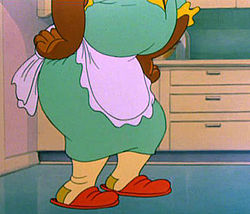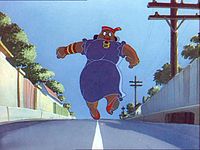- Mammy Two Shoes
-
Mammy Two Shoes Tom and Jerry character 
From Old Rockin' Chair TomFirst appearance Puss Gets the Boot (1940) Last appearance Push-Button Kitty (1952) Created by William Hanna and Joseph Barbera Voiced by Lillian Randolph
Thea Vidale
(dubbed versions)Information Species Human Gender Female Family Pet: Tom Relatives Aunt Harriet (mentioned, not heard or seen in The Million Dollar Cat). Mammy Two Shoes (sometimes Mrs. Two Shoes) is a recurring character in MGM's Tom and Jerry cartoons. She is a heavy-set middle-aged black woman who often has to deal with the mayhem generated by the lead characters.
As a partially-seen character, she was famous for never showing her face (except very briefly in Saturday Evening Puss). Mammy's appearances have often been edited out, dubbed, or re-animated as a slim white woman in later television showings, since her character is a mammy archetype now often regarded as racist. It was later revealed that her character was greatly inspired by Oscar-winning black actress and singer Hattie McDaniel, best known for playing "Mammy" in MGM and David O. Selznick's 1939 film Gone with the Wind.
A character very similar to Mammy Two Shoes had earlier been portrayed in the Disney Silly Symphonies shorts Three Orphan Kittens and More Kittens, as well as the Pluto short Pantry Pirate and the Figaro short Figaro and Cleo. A similar character Aunt Petunia the Mammy actually shows her face which resembles blackface in The Little Audrey Cartoon Series.
Contents
Theatrical Tom and Jerry cartoons
 Mammy Two Shoes, in a scene from the Tom & Jerry short Saturday Evening Puss, whose full face was shown for the first time.
Mammy Two Shoes, in a scene from the Tom & Jerry short Saturday Evening Puss, whose full face was shown for the first time.
Mammy first appeared in Puss Gets the Boot, the first Tom and Jerry cartoon (except Tom was called "Jasper"). She always referred to Tom as his given name Thomas and almost always used "is" in conjunction with a pronoun ("is you" and "I is"). The character went on to make many appearances through the entire series until 1952 and her last appearance in the short, Push-Button Kitty. William Hanna and Joseph Barbera initially portrayed Mammy as the maid of the house, with the real owners unknown to us. Later, Hanna and Barbera seemed to suggest, through dialogue and occasional behavior, that the house was Mammy's own.
Mammy was originally voiced by well-known African-American character actress Lillian Randolph. In the 1960s, the MGM animation studio, by then under the supervision of Chuck Jones, created censored versions of the Tom & Jerry cartoons featuring Mammy for television. These versions used rotoscoping techniques to replace Mammy on-screen with a similarly-stocky white woman (in most shorts) or a thin white woman (in Saturday Evening Puss); Randolph's voice on the soundtracks was replaced by an Irish-accented (or, in Puss, generic young adult) voice performed by white actress June Foray.[1]
The original versions of the cartoons were reinstated when Turner Broadcasting acquired ownership of the Tom & Jerry property. But in 1992, the cartoons featuring Mammy were edited again; this time, to replace Lillian Randolph's voice with that of Thea Vidale, who re-recorded the dialogue to remove Mammy's use of potentially offensive dialect. These re-recorded versions of the cartoons are aired to this day on Turner's Cartoon Network-related cable channels, and have at times turned up on DVD as well. However, some European TV showings of these cartoons, especially the UK, retain Randolph's original voice. The Region 2 Complete Collectors Edition DVD boxset has Vidale's voice on the first DVD and Randolph in a number of the episodes after that (such as A Mouse in the House and Mouse Cleaning).
Replacement characters for Mammy
From 1954's Pet Peeve, Mammy disappeared from Tom and Jerry; the owners of the animals' house became a young, white, middle-class couple named Joan and George, and starting with 1955's The Flying Sorceress, the audience was able to see these owners' heads.
In 1961, when Rembrandt Films began producing Tom and Jerry shorts, the owner of the house became a corpulent white man. The character was designed by Gene Deitch, who recycled the design from his Terrytoons character Clint Clobber.[2] This new owner, whose face would turn bright red, and often derived great glee in doing so, was more graphically brutal in punishing Tom's mistakes as compared to Mammy Two Shoes, such as beating and thrashing Tom repeatedly, searing his face with a grill and forcing Tom to drink an entire carbonated beverage. "Clobber" (for want of a better name) was introduced in Down and Outing as a fisherman who owned Tom as well as their house. "Clobber" later appeared in High Steaks as a chef, and Sorry Safari as a hunter before being dropped.
Later, Tom's owner varied, with a housewife similar to the re-edited Mammy appearing in the later Deitch short Buddies Thicker Than Water and the direct-to-DVD film Tom and Jerry: The Fast and the Furry.
Tom and Jerry Tales and Mammy's modern return
In the modern Tom and Jerry Tales a redesigned Mammy has appeared, debuting in the short Ho, Ho Horrors and turning up again later on. Though keeping her buxom, overweight build, tough personality, Southern accent and tendency to call Tom "Thomas," Mammy's skin tone has changed to white, presumably to avoid any possible controversy. Several photos on a mantel in Ho, Ho Horrors also imply that Mammy now has a family (a man and a boy, also shown only as legs and partial torsos), though they have yet to appear in actual animation. In the short Power Tom the story casts Mammy as a superheroine called Power Gal, though it's only for this one cartoon.
In the new shorts, the now-Caucasian Mammy is explicitly called "Mrs. Two-Shoes".
Featured shorts
Tom and Jerry
- Puss Gets the Boot (1940)
- The Midnight Snack (1941)
- Fraidy Cat (cameo) (1942)
- Dog Trouble (cameo) (1942)
- Puss N' Toots (cameo) (1942)
- The Lonesome Mouse (1943)
- The Mouse Comes to Dinner (cameo) (1945)
- Part Time Pal (1947)
- A Mouse in the House (1947)
- Old Rockin' Chair Tom (1948)
- Mouse Cleaning (1948)
- Polka-Dot Puss (1949) (cameo)
- The Little Orphan (cameo) (1949)
- Saturday Evening Puss (1950)
- The Framed Cat (cameo) (1950)
- Casanova Cat (cameo) (1951)
- Sleepy-Time Tom (1951)
- Nit-Witty Kitty (1951)
- Triplet Trouble (1952)
- Push-Button Kitty (1952)
Tom and Jerry Tales (as Mrs. Two Shoes)
- Prehisterics
- Ho, Ho Horrors (cameo)
- Tin Cat of Tomorrow
- Power Tom
- Cat Show Catastrophe (cameo)
- The Cat Whisperer
- Adventures in Penguin Sitting
- Invasion of the Body Slammers (cameo)
- Sasquashed
- Summer Squashing
- Little Big Mouse
- You're Lion
- Monkey Chow
- Game of Mouse and Cat
Major appearances
- The Lonesome Mouse - She's tricked by Tom's and Jerry's truce.
- Part Time Pal
- Old Rockin' Chair Tom - She takes a cat named Lightning.
- Sleepy-Time Tom - She keeps an eye on Tom if he's sleeping on the job.
- Push-Button Kitty - She orders a robocat called Mechano.
- Tin Cat of Tomorrow - She orders a robocat called Mechanico.
- Power Tom - She disguises herself as Power Gal to save Tom and Jerry from Butch, Lightning and Topsy in robbing.
- Saturday Evening Puss- she forbids Tom from secretly throwing a party and while she goes to play with her friends, Tom disobeys her orders and invites his gang to his secret party.
Voice actors who portrayed Mammy Two Shoes
- Lillian Randolph: 1940 - 1952
- Thea Vidale: (dubbed versions) (uncredited)
- June Foray: Mammy as a thin white woman
- Nicole Oliver: Tom and Jerry Tales
- Roz Ryan (Live action)
References
Tom and Jerry Characters - Tom Cat
- Jerry Mouse
- Tuffy
- Spike and Tyke
- Mammy Two Shoes
Theatrical shorts DVD releases of shorts - Spotlight Collection
- Golden Collection
Television shows and theatrical films - The Tom and Jerry Show
- Tom & Jerry Kids
- Tom and Jerry Tales
- Tom and Jerry: The Movie
Television specials and direct-to-video films - Hanna-Barbera's 50th: A Yabba Dabba Doo Celebration
- The Mansion Cat
- The Magic Ring
- Blast Off to Mars
- The Fast and the Furry
- Shiver Me Whiskers
- A Nutcracker Tale
- Meet Sherlock Holmes
- The Wizard of Oz
Other formats - Video games
- Soundtrack series
Related See also: List of works produced by Hanna-BarberaHanna-Barbera characters Tom and Jerry The Flintstones Scooby-Doo The Jetsons George Jetson · Jane Jetson · Judy Jetson · Elroy Jetson · Astro · Rosie the Robot Maid · Mr. SpacelyYogi Bear and Huckleberry Hound Yogi Bear · Boo-Boo Bear · Ranger Smith · Cindy Bear · Snagglepuss · Yakky Doodle · Huckleberry Hound · Pixie and Dixie and Mr. Jinks · Hokey WolfQuick Draw McGraw The Smurfs Magilla Gorilla Peter Potamus Jonny Quest Space Ghost Wacky Races Top Cat Atom Ant and Secret Squirrel The Hanna-Barbera New Cartoon Series Grape Ape Grape Ape · Beegle BeagleOther Categories:- Fictional African-American people
- Tom and Jerry characters
- Fictional characters introduced in 1940
- Political correctness
Wikimedia Foundation. 2010.
